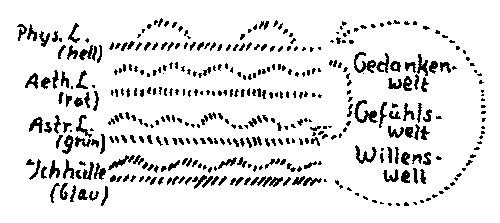Soul forces
Three basic soul forces or soul faculties that shape the soul life of modern man can be clearly distinguished: thinking, feeling and willing. This threefold structure of the soul's life was first clearly described by Johannes Nikolaus Tetens (1736-1807), who aimed for a "psychological analysis of the soul" according to the method of natural science.
The separation of these three soul forces is not equally pronounced in all three soul members. In the sentient soul, thinking, feeling and willing are still very strongly interwoven. In the intellectual or mind soul, the will is already clearly set apart, while thinking and feeling are still closely connected with each other. Only with the consciousness soul does the complete separation of all three soul forces begin. A complete separation of the three soul forces is also achieved by a correspondingly advanced spiritual training, which leads up to a splitting of the personality. However, one must not imagine this separation of the three soul forces as a schematic juxtaposition:
„We distinguish between these three soul faculties, thinking, feeling and willing, but in the unified life of the soul they are not strictly separated from each other. One should actually say: When we speak of thinking, of imagining, we are speaking of a soul faculty in which, for example, the will and also feeling are certainly inside, but it is mainly thinking that is inside. In the will, on the other hand, there are certainly thoughts inside, but it is mainly the will that is inside. Thus it is only the most prominent thing that is designated in the individual soul faculties, while everywhere under the surface, one may say, lie the other soul faculties also.“ (Lit.:GA 82, p. 120f)
In Germanic mythology, the three powers of the soul are referred to by the gods Odin, Vili and Vé.
Soul Forces and Essential Members
The soul forces unfold through the activity of the four fundamental members of man. Thinking weaves between the physical body and the etheric body, feeling vibrates between the etheric body and the astral body, and willing works between the I and the astral body.
„There is first the physical body of man (see drawing, light); there is then the etheric body of man (red). Between the two is the weaving world of thought, in so far as it is integrated into our organism. Between the etheric body and the astral body (green) is the world of feeling, and between the astral body and the ego-shell (blue) is the world of will.“ (Lit.:GA 208, p. 15)

Literatur
- Johannes Nikolaus Tetens: Philosophische Versuche über die menschliche Natur und ihre Entwicklung. 2 Bde. Weidmann, Leipzig 1777
- Rudolf Steiner: Anthroposophische Leitsätze, GA 26 (1998), ISBN 3-7274-0260-1 English: rsarchive.org German: pdf pdf(2) html mobi epub archive.org
- Rudolf Steiner: Damit der Mensch ganz Mensch werde, GA 82 (1994), ISBN 3-7274-0820-0 English: rsarchive.org German: pdf pdf(2) html mobi epub archive.org
- Rudolf Steiner: Grundelemente der Esoterik, GA 93a (1987), ISBN 3-7274-0935-5 English: rsarchive.org German: pdf pdf(2) html mobi epub archive.org
- Rudolf Steiner: Das Lukas-Evangelium, GA 114 (2001), ISBN 3-7274-1140-6 English: rsarchive.org German: pdf pdf(2) html mobi epub archive.org
- Rudolf Steiner: Die Mission einzelner Volksseelen im Zusammenhang mit der germanisch-nordischen Mythologie, GA 121 (1982), 5. Aufl., ISBN 3-7274-1210-0 English: rsarchive.org German: pdf pdf(2) html mobi epub archive.org ; 6. Aufl., stark bearbeitete und erweiterte Neuauflage 2017: ISBN 3727412119
- Rudolf Steiner: Anthroposophie als Kosmosophie – Zweiter Teil, GA 208 (1992), ISBN 3-7274-2080-4 English: rsarchive.org German: pdf pdf(2) html mobi epub archive.org
- Rudolf Steiner: Esoterische Unterweisungen für die erste Klasse der Freien Hochschule für Geisteswissenschaft am Goetheanum 1924, GA 270/2 (1999), ISBN 3-7274-2700-0 English: rsarchive.org German: pdf pdf(2) html mobi epub archive.org
- Rudolf Steiner: Geisteswissenschaftliche Erläuterungen zu Goethes «Faust», Band I: Faust, der strebende Mensch , GA 272 (1981), ISBN 3-7274-2720-5 English: rsarchive.org German: pdf pdf(2) html mobi epub archive.org
- Rudolf Steiner: Allgemeine Menschenkunde als Grundlage der Pädagogik, GA 293 (1992), ISBN 3-7274-2930-5 English: rsarchive.org German: pdf pdf(2) html mobi epub archive.org
- Rudolf Steiner: Vorträge und Kurse über christlich-religiöses Wirken, II, GA 343a (1993), ISBN 3-7274-3430-9 English: rsarchive.org German: pdf pdf(2) html mobi epub archive.org
 |
References to the work of Rudolf Steiner follow Rudolf Steiner's Collected Works (CW or GA), Rudolf Steiner Verlag, Dornach/Switzerland, unless otherwise stated.
Email: verlag@steinerverlag.com URL: www.steinerverlag.com. Index to the Complete Works of Rudolf Steiner - Aelzina Books A complete list by Volume Number and a full list of known English translations you may also find at Rudolf Steiner's Collected Works Rudolf Steiner Archive - The largest online collection of Rudolf Steiner's books, lectures and articles in English. Rudolf Steiner Audio - Recorded and Read by Dale Brunsvold steinerbooks.org - Anthroposophic Press Inc. (USA) Rudolf Steiner Handbook - Christian Karl's proven standard work for orientation in Rudolf Steiner's Collected Works for free download as PDF. |
